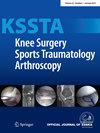Wearable health technology finds improvements in daily physical activity levels following total knee arthroplasty: A prospective study
Abstract
Purpose
Wearable technologies, like the Apple Watch, offer new possibilities for collecting objective data on physical activity post-operatively following total knee arthroplasty (TKA). This study aims to describe changes in daily physical activity levels using objective metrics over different time points following TKA.
Methods
This study analyzed data from a prospective cohort of 152 patients undergoing a unilateral TKA. Patients wore an Apple Watch and used a digital care management application for data collection. Step count, steadiness, standing duration, gait speed and performance on a 6-min walk test were collected from Apple HealthKit at multiple time points: pre-operative, 6 weeks post-operatively, 6 months post-operatively and 12 months post-operatively. Statistical analyses were performed using R software, including descriptive statistics and paired t tests to compare outcomes at different time points post-operatively.
Results
Participants demonstrated significant improvements in daily physical activity levels over the course of 12 months post-operative. At 6 months post-operative, participants showed the highest average daily step count (mean ± SD: 5293 ± 236 steps; p < 0.001), with improvements persisting at 12 months post-operative (5180 ± 260 steps; p < 0.001) compared to preoperative values. Gait speed increased from 0.88 ± 0.01 m/s preoperatively to 1.01 ± 0.01 m/s (p = 0.006) at 12 months post-operative. Standing hours increased from 9.99 ± 0.30 to 11.47 ± 0.31 h at 6 months post-operative and persisted. Steadiness and the estimated 6-minute walk test showed recovery trends, though variability remained at 12 months post-operative, suggesting the need for additional longitudinal assessment
Conclusion
This study provides one of the first longitudinal analyses of post-operative functional recovery using Apple HealthKit, offering continuous real-world gait and activity tracking beyond traditional patient-reported measures. These findings highlight the value of wearable technology in monitoring post-operative activity and offering insights into TKA recovery patterns. The study suggests a critical recovery window at 6 months post-operative and emphasizes the need for ongoing support to maintain improvements. The integration of wearable technology in post-operative monitoring offers a promising approach to tracking patient progress and optimizing functional outcomes following TKA.
Level of Evidence
Level II.






 求助内容:
求助内容: 应助结果提醒方式:
应助结果提醒方式:


